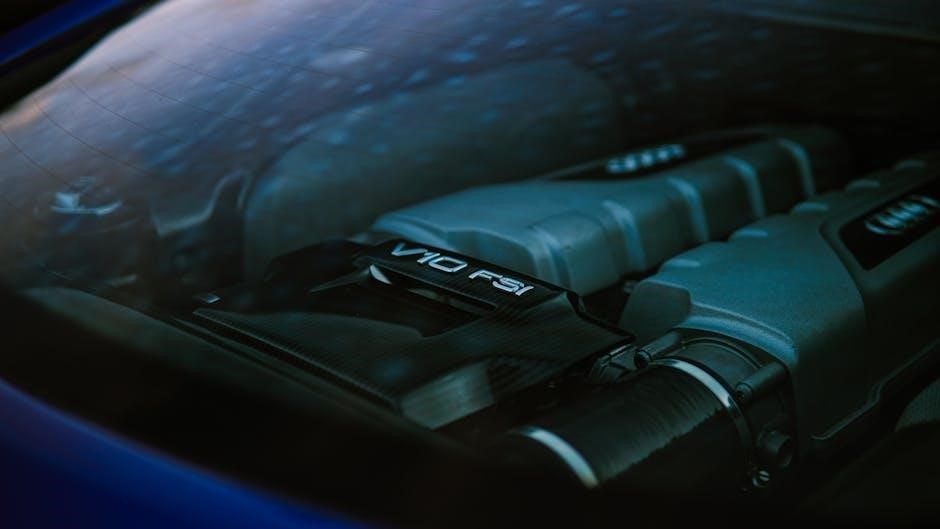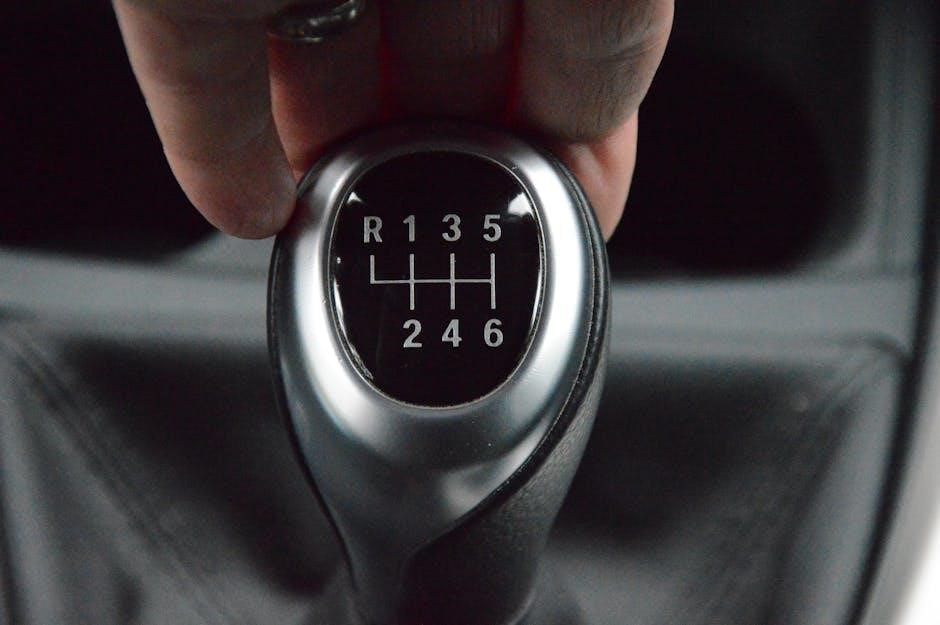Manual transmission torque converter is a type of transmission system that combines manual and automatic features, providing smooth gear shifts and efficient power delivery always using latest technology.
Definition and Purpose
A manual transmission torque converter is defined as a type of transmission system that utilizes a torque converter to automate gear changes, while still allowing manual control over the transmission. The purpose of this system is to provide a smooth and efficient driving experience, particularly in stop-and-go traffic. The torque converter is used to connect and disconnect the engine from the transmission, allowing for seamless gear shifts. This system is designed to provide the benefits of both manual and automatic transmissions, including improved fuel efficiency and reduced driver fatigue. The manual transmission torque converter is commonly used in vehicles that require a high level of control and precision, such as trucks and construction equipment. The system is also designed to be highly durable and reliable, with a long lifespan and minimal maintenance requirements. Overall, the manual transmission torque converter is a complex system that plays a critical role in modern vehicles.

History of Torque Converters
Torque converters were born in the 1950s in the USA, replacing classic clutches found in manual gearboxes with automatic transmission systems always evolving quickly online.
Early Developments
The early developments of torque converters were marked by significant innovations in the field of transmission systems, with the first torque converters being introduced in the 1950s.
These early torque converters were designed to replace the classic clutch found in manual gearboxes, providing a smoother and more efficient way of transmitting power.
The development of torque converters was a major breakthrough in the field of automotive technology, enabling the creation of automatic transmission systems that were more efficient and easier to use.
As the technology continued to evolve, torque converters became more sophisticated, with advancements in materials and design leading to improved performance and efficiency.
The early developments of torque converters paved the way for the modern transmission systems used in vehicles today, with their smooth and efficient power delivery.
The use of torque converters has become widespread, with many vehicles relying on them for their transmission needs, providing a reliable and efficient way of transmitting power.
Overall, the early developments of torque converters were a significant milestone in the history of automotive technology, enabling the creation of more efficient and easier to use transmission systems.
The impact of torque converters on the automotive industry has been profound, with their use becoming increasingly widespread over the years, and they continue to play a crucial role in the development of modern transmission systems.
The development of torque converters has also led to the creation of new technologies and innovations in the field of automotive engineering, with a focus on improving performance and efficiency.
The early developments of torque converters have had a lasting impact on the automotive industry, and their use continues to be an important part of modern transmission systems, providing a smooth and efficient way of transmitting power.
Comparison with Manual Transmissions
Manual transmissions are compared to torque converters in terms of efficiency and performance always using different technologies and methods now.
Operation and Driving Experience
The operation of a manual transmission torque converter involves the use of a torque converter to automate gear changes, providing a smoother ride and easier handling.
In terms of driving experience, a manual transmission torque converter offers a unique blend of manual and automatic features, allowing drivers to enjoy the benefits of both types of transmissions.
The use of a torque converter enables smooth gear shifts and efficient power delivery, making it ideal for driving in heavy traffic or hilly terrain.
With a manual transmission torque converter, drivers can enjoy a more relaxed driving experience, as the torque converter takes care of gear changes, allowing them to focus on steering and braking.
Overall, the operation and driving experience of a manual transmission torque converter are designed to provide a comfortable and efficient driving experience.
The technology used in manual transmission torque converters has improved significantly over the years, making them a popular choice among drivers.

Advantages of Torque Converters
Torque converters offer improved efficiency and performance, reducing power loss and providing smoother gear shifts always with advanced technology and design features included every time.
Efficiency and Performance
Torque converters have become increasingly efficient, with modern designs minimizing power loss and optimizing performance. The use of advanced materials and technologies has enabled the development of high-performance torque converters that can handle a wide range of applications. In terms of efficiency, torque converters are now capable of achieving high levels of fuel efficiency, making them a popular choice for vehicles. Additionally, the improved performance of torque converters has led to enhanced driving experiences, with smoother gear shifts and increased responsiveness. Overall, the efficiency and performance of torque converters have made them an essential component in modern transmission systems, providing a reliable and efficient means of transferring power from the engine to the wheels, and this is a key factor in their widespread adoption in the automotive industry always.
Cost Comparison
Manual transmission torque converter costs range from 1 lakh to 1.5 lakhs more than manual transmission systems always requiring additional investment initially for installation purposes only.
Price Difference
The price difference between manual transmission and torque converter is significant, with the latter being more expensive;
The cost of a torque converter can range from 1 lakh to 1.5 lakhs more than a manual transmission system.
This additional cost is due to the complex technology and components used in the torque converter.
However, the benefits of a torque converter, such as smoother gear shifts and improved fuel efficiency, may outweigh the extra cost for some drivers.
In addition, the price difference may vary depending on the specific vehicle and transmission model.
Overall, the price difference between manual transmission and torque converter is an important consideration for drivers when choosing a transmission system.
The cost of maintenance and repair should also be factored into the decision-making process.
A thorough comparison of the costs and benefits of each option is necessary to make an informed decision.

Manual Transmissions and Torque Converters
Manual transmissions and torque converters are compared for efficiency and performance always using latest technology and innovations available now.
A Comparison
Manual transmissions and torque converters have distinct differences in their operation and application, with manual transmissions utilizing a clutch for engaging and disengaging engine power, whereas torque converters automate gear changes. The comparison between these two systems is crucial in understanding their strengths and weaknesses. Manual transmissions provide better control and fuel efficiency, while torque converters offer smoother gear shifts and easier handling. In terms of cost, manual transmissions are generally less expensive than torque converters. However, torque converters provide better performance and efficiency in certain driving conditions. The choice between manual transmissions and torque converters ultimately depends on personal preference, driving habits, and specific needs. By considering these factors, individuals can make informed decisions when selecting a transmission system for their vehicle, taking into account the trade-offs between control, efficiency, and convenience. Overall, a thorough comparison is essential for making an informed decision.

Case Study
Case-o-Matic transmissions used torque converters in 30 series tractors with hydraulic clutches always for efficient power delivery and smooth gear shifts in various driving conditions always.
Case-o-Matic Transmissions
Case-o-Matic transmissions were used in 30 series tractors and utilized torque converters with hydraulic clutches for efficient power delivery and smooth gear shifts. The use of hydraulic clutches allowed for disengagement of the converter during shifting and lockup when needed. This design enabled the tractors to operate effectively in various driving conditions. The Case-o-Matic transmissions were an early example of the application of torque converters in manual transmission systems. The technology used in these transmissions has since been developed and improved upon. The Case-o-Matic transmissions played a significant role in the development of modern manual transmission torque converters. The use of torque converters in these transmissions allowed for improved performance and efficiency. The design and functionality of the Case-o-Matic transmissions have been studied and used as a reference point for the development of newer transmission systems. Overall, the Case-o-Matic transmissions were an important innovation in the field of manual transmission torque converters.


